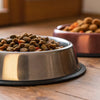Is It OK to Soften Dry Dog Food with Water? Exploring the Benefits and Risks
- Houndsy
Table of Contents
- Introduction
- The Benefits of Softening Dry Dog Food
- The Drawbacks of Softening Dry Dog Food
- Best Practices for Soaking Dry Dog Food
- Conclusion
Introduction
As responsible pet owners, we constantly seek the best ways to nourish our furry friends. Did you know that studies have shown that nearly 80% of dogs can experience digestive discomfort at some point in their lives? With this in mind, many dog owners wonder: is it ok to soften dry dog food with water? This question is more than just a casual inquiry; it strikes at the heart of our desire to ensure our pets enjoy their meals while also supporting their health.
In this blog post, we will explore the various aspects of softening dry dog food with water, including the potential benefits and drawbacks, the best practices for doing so, and how this practice can impact your dog's overall well-being. By the end, you will have a comprehensive understanding of whether or not adding water to your dog's kibble is the right choice for your beloved companion.
Let's dive into the topic together and reflect on our own dog feeding routines. Are we doing what's best for our dogs, or could a simple adjustment make a world of difference?
The Benefits of Softening Dry Dog Food
Enhanced Palatability
One of the most immediate benefits of adding water to dry dog food is the enhancement of flavor. When kibble is soaked, it releases its aromas, making mealtime more enticing for your dog. This can be particularly beneficial for picky eaters or dogs recovering from an illness, as the wet food can be more appealing and easier to consume.
- Example: Many dog owners have observed that their dogs gobble up softened kibble much faster than dry kibble. This simple change can transform a mundane meal into a delicious treat, ensuring your dog is excited about their food.
Improved Hydration
Dogs can sometimes be reluctant to drink enough water, leading to dehydration, especially during hot weather or after vigorous exercise. By adding water to their kibble, you not only increase their fluid intake but also help maintain proper hydration levels.
- Insight: According to veterinary studies, proper hydration is crucial for maintaining healthy bodily functions, including digestion and nutrient metabolism. Softening kibble can thus serve as a proxy for those dogs that struggle to drink sufficient water.
Easier to Chew and Digest
For senior dogs or those with dental issues, dry kibble can be challenging to chew. Softening the food makes it easier for these dogs to eat, reducing the risk of choking and allowing them to enjoy their meals without discomfort.
- Hypothetical Scenario: Imagine an elderly dog with missing teeth. Soaking their kibble can make a world of difference, turning a potentially painful experience into a comfortable one.
Slowed Eating
Some dogs are notorious for wolfing down their food, which can lead to digestive issues like bloating. Adding water to kibble can slow down their eating process, making mealtimes more manageable and reducing the risk of gastrointestinal problems.
- Tip: By creating a more enjoyable and less hurried eating experience, you can help your dog develop healthier eating habits over time.
Nutrient Absorption
Soaking dry kibble can aid in the breakdown of nutrients, potentially enhancing their absorption during digestion. This can be particularly advantageous for dogs with sensitive stomachs or those recovering from illness.
- Research Insight: Some studies suggest that moistened food may facilitate improved nutrient bioavailability, allowing your dog to reap the full benefits of their diet.
The Drawbacks of Softening Dry Dog Food
Potential for Spoilage
One of the primary concerns with adding water to kibble is the risk of spoilage. Wet food can harbor bacteria and mold if left out for too long, which can lead to gastrointestinal upset in dogs.
- Precaution: It's crucial to serve the moistened kibble immediately and avoid leaving it out for more than 60 minutes, especially in warm weather.
Dental Health Considerations
While softened kibble can be easier on the teeth for older dogs, dry kibble has its advantages in dental health. The crunchiness of dry kibble can help scrape away plaque and tartar buildup, promoting better oral hygiene.
- Balance: If your dog has healthy teeth, consider maintaining a balance between dry and softened food to support their dental health.
Nutritional Changes
Introducing water to kibble can alter the nutritional profile of the food. Water-soluble vitamins and minerals may dissolve into the water, potentially reducing the overall nutrient content available to your dog.
- Consultation: If you're considering this method, it's wise to consult your veterinarian to ensure that your dog's nutritional needs are still being met.
Mess and Convenience
Moistened kibble can be messier than dry kibble, creating more work for pet owners in terms of cleaning. It may also complicate feeding routines, particularly if you are on the go.
- Considerations: If you frequently travel with your dog, consider how this change might affect your routine and whether you can adapt accordingly.
Best Practices for Soaking Dry Dog Food
Start Slowly
When transitioning to softened kibble, it's important to do so gradually. Start by adding a small amount of water and gradually increase it to find the right consistency that suits your dog's preference.
- Tip: Observe your dog's reactions and adjust the water content based on their comfort level.
Use Warm Water
Warm water can help release the flavors and aromas of the kibble, making it more appealing to your dog. However, ensure the water is not too hot, as this could burn your pet's mouth.
- Recommendation: Aim for water at a temperature similar to that of human skin, around 30-40 degrees Celsius.
Serve Immediately
Once you've soaked the kibble, serve it right away to prevent spoilage. If your dog doesn't eat it all, discard the leftovers after an hour to avoid any health risks.
- Reminder: Always prioritize your dog's health and safety when introducing changes to their diet.
Monitor Your Dog's Response
Pay attention to how your dog reacts to the moistened food. If you notice any signs of discomfort, digestive upset, or changes in appetite, consult your veterinarian.
- Reflection: Each dog is different, and their needs may vary. Tailoring the feeding approach is essential for ensuring their well-being.
Conclusion
In summary, softening dry dog food with water can offer a multitude of benefits, particularly for those dogs that struggle with hydration, dental issues, or picky eating habits. However, it's essential to weigh these advantages against potential risks, such as spoilage and changes to dental health.
As dog owners, we must remain vigilant about our furry friends' dietary needs and preferences. By considering the insights shared in this post, we can make informed decisions that enhance their daily feeding experiences.
Ready to elevate your dog's feeding ritual? Explore our innovative Houndsy Kibble Dispenser to make mealtime simpler, more enjoyable, and beautifully integrated into your home decor!
FAQ
Can I leave moistened kibble out for a long time?
No, it is best to serve moistened kibble immediately and not leave it out for more than an hour to prevent spoilage.
Will softening kibble impact my dog's dental health?
While softened kibble can be easier for dogs with dental issues, dry kibble has benefits for dental health by helping to scrape away plaque. Balance is key.
What type of water should I use to soften kibble?
Use warm water—not hot—to help release flavors and aromas while ensuring it is safe for your dog to consume.
How can I tell if my dog likes the moistened kibble?
Observe your dog's eating habits. If they eat the moistened kibble eagerly and appear satisfied, it's likely a hit!
Should I consult a vet before changing my dog's diet?
Yes, it's always a good idea to consult your veterinarian when making changes to your dog's diet to ensure their nutritional needs are being met.












